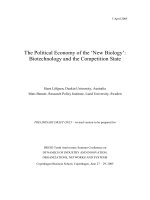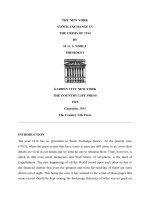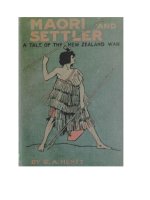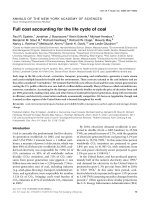ZOOLOGICA, SCIENTIFIC CONTRIBUTIONS OF THE NEW YORK ZOOLOGICAL SOCIETY V2
Bạn đang xem bản rút gọn của tài liệu. Xem và tải ngay bản đầy đủ của tài liệu tại đây (30.19 MB, 607 trang )
ZOOLOGICA
SCIENTIFIC CONTRIBUTIONS OF THE
NEW YORK ZOOLOGICAL
VOLUME
OCTOBER
1915-1923
Numbers
II
AUGUST
1-18 Inclusive
PUBLISHED BY THE
THE
SOCIETY
ZOOLOGICAL
PARK,
1924
SOCIETY
NEW
YORK
;
;
General Office:
101
Park Avenue, New York
©ffirpfH
Honorary President, Henry Fairfield Osborn;
Vice-Presidents, Madison Grant and Frank K. Sturgis;
Secretary, Chairman, Exec. Committee, Madison Grant;
Ireeisurer, Cornelius E. Agnew
Haarb of ManaQets
uilaHB nf
igas
Percy R. Pyne, George Bird Grinnell, Cleveland H. Dodge, C. Ledyard Blair,
Anthony R. Kxtser, Mortimer L. Schiff, Frederic C. Walcott,
Beekman Winthrop, George C. Clark, Jr., W. Redmond Cross,
Henry Fairfield Osborn, Jr.. Arthur A. Fowler.
OliaBB nf
laaB
Henry Fairfield Osborn. Lispenard Stewart. Charles
F.
F. Dieterich,
Baker, Wm. Pierson Hamilton, Robert S. Brewster, Edward
Harkness, William B. Osgood Field. Edavin Thorne, Percy
A. Rockefeller, John E. Beravind, Iraqng K. Taylor.
ffllaaa
George
S.
nf lasr
Madison Grant, William White Niles, Frank K. Sturgis, Ogden Mills,
Lewis Rutherfurd Morris, Archer M. Huntington, George D. Pratt,
T. Coleman duPont. Henry D. Whiton, Cornelius R.
Agnew, Harrison Williams. Marshall Field.
Srtpnttfir g'taflf
William T. Horn ad ay, Director of
W. Reid Blair, Assistant to
Charles H. Toavnsend. Director
the Zoological
Park;
the Director;
of the Aquarium
L. Ditmars, Curator of Reptiles;
Beebe, Honorary Curator of Birds and Director of
Raymond
William
Department of Tropical Research
Lee S. Crandall. Curator of Birds;
George S. Huntington, Prosector;
Elwin
R. Sanborn. Photographer and Editor.
lEftttnrtal
Qlommtttrp
Madison Grant, Chairman; William T. Hornaday. Charles H. Toavnsend,
William Beeibb, Elavin R. Sanborn, Secretary.
TITLES OF PAPERS
PAGE
1
2
— Two Series of
— A Tetrapteryx
3— Birds
4
3
Beehc
39
Bcchc
55
BccTjc
107
Gudgcr
125
Le Boucf
1(37
Bccbc
205
Ears fall
2-13
Crandall
255
Welsh and Brcdcr
261
Brcdcr
281
Brcdcr and Crawford
287
Brcdcr
331
Friedman
355
Mellen and Van Oosten
375
Nuble
417
Stage in the Aiieestry of Birds
of Para, Brazil
— Fauna
5— The
Dcckcrt
Amphibians
of
Jungle Debris
Gaff-Topsail
6— Mammals
of Australia
7.8-9— Higher Vertebrates, British Guiana
10— Habits
11
—Eclipse
12—Life
of the Sage Grouse
Plumage
in
Domestic Fowl
History of the Puff'er
13
— Hermaphroditism
11
— Food
of Certain
15— Fishes
of
of a Croaker
Minnows
Sandy Hook Bay
—Weaving of the
17 — The Whitefishes
16
18— The Anderson
Weaver Bird
Tree Frog
.
LIST OF ILLUSTRATIONS
Fig.
ILLUSTRATIONS
PAGE
Fig. 28.
Skull of the Gaff-topsail
148
Fig. 29.
Ventral surface of skull
150
Fig. 30.
Gaff-topsail that has just burst the shell
152
Fig. 31.
Larvae of Gaff-topsail
152
MAMMALS OF AUSTRALIA
Figures 32
Fig.
IN
io
THE ZOOLOGICAL PARK
G8 inclusive
Typical forest in the Province of Victoria, Australia
Australia: Great Britain's Southeastern
Young Gray Kangaroo, M. gigantus
Wallaroo or Euro Kangaroo
Woodward Kangaroo
Kangaroo
Parry Kangaroo
Giant Red Kangaroo
Kangaroo Island Kangaroo
Bennett Tree Kangaroo
Bennett Tree Kangaroo
Captive Tree Kangaroo
Rufous-necked Wallaby
Black-faced
Brush-tailed
16T
169
176
176-177
176-177
176-177
176-177
176-177
176-177
176-177
176-177
176-177
176-177
176-177
Phascogale
Bennett Tree Kangaroo
Albino Red Kangaroo
Albino Red-bellied Wallaby
Ring-tailed
Empire
Wallaby
176-177
176-177
176-177
176-177
Brush-tailed Wallabies
176-177
Black Swamp-Wallaby
176-177
Male of the Swamp-Wallaby
Agile Wallaby
The home of the Tree Wallaby
Short-tailed Wallaby
Rat-Kangaroo
Australian Gray Phalanger
Koala or native Bear
Koala in its tree-top haunt
176-177
Fat-tailed
Opossum Mouse
177
179
192
192-193
192-193
192-193
192-193
192-193
Flying-Phalanger
192-193
Rabbit-eared Bandicoot
192-193
Wombat and young
192-193
Tasnianian Wolf
A
family of Tasmanian
Under surface
193
Devils
of the Echidna
Echidna in normal attitude
The Platypus or Duck-bill
197
198
198
201
ILLVSTEATIONS
REMARKABLE HABITS OF THE SAGE GROUSE
Fif/iires 69 to 76 inclusive
PAGE
Fig. 75.
Sage Grouse displaying
Filling pouch with air
Stiff-legged run after filling
Lifting pouch with the wings
Side view of lift of the pouch
Extreme of throw of the pouch
Slap down of pouch on chest
Fig. 76.
Sage
Fig. 69.
Fig. 70.
Fig. 71.
Fig. 72.
Fig. 73.
Fig. 74.
241
246
246
247
247
248
248
249
Grouse
ECLIPSE PLUMAGE IN DOMESTIC FOWL
Fiffures 77 to 79 inclusive
Fig. 77.
Fig. 78.
Fig. 79.
Game Cock showing hackle
Red Jungle Fowl
Feathers of Game Cock
in eclipse
253
253
256
A CONTRIBUTION TO THE LIFE HISTORY OF THE PUFFER
Figures 80
to 96 inclusive
Fig. 80.
Larva
Fig. 81.
Magnification
Fig. 82.
Newly hatched
Fig. 83.
Larval
Fig. 84.
Larval
fish
five
Fig. 85.
Larval
fish
seven days after hatching
Fig. 86.
Post larval
fish
Fig. 87.
Adult
partly
Fig. 88.
Detail of head of newly hatched larva
268
Fig. 89.
Detail of vent of two day old larva
269
Fig. 90.
Profile of lateral
Fig. 91.
Tip of
Fig. 92.
Spines from ventral surface of ten day larva
270
Fig. 93.
Outline of a specimen
271
Fig. 94.
Dorsal view, same specimen
271
Fig. 95.
Horizontal index
274
Fig. 96.
Horizontal
275
five
fish
fish,
tail
days after hatching
egg
of
261
262
266
fish
one day after hatching
days after hatching
266
266
267
267
of six
inflated
organ
day old larva
—chart
index— chart
267
270
270
HERMAPHRODITISM OF A CROAKER
Ficjure 97
Fig. 97.
Croaker
— Anatomical
chart
282
THE FOOD OF CERTAIN MINNOWS
Figures 98 to 128 inclusive
Fig.
98.
Map
Fig.
99.
View looking up stream
of collecting site
290
292
ILLVSTBATWl^S
PAGE
292
Fig. 100.
View looking down stream
Fig. 101.
Contents, stomach and intestine, cornutus
293
Fig. 102.
Contents, stomach and intestine, cornutus
293
Fig. 103.
Semotilus
304
Fig. 104.
Leuciscus vandoisulus
Fig. 105.
Leuciscus vandoisulus
Fig. 106.
Fig. 107.
Notropis procne
Notropis cornutus
Fig. 108.
Notropis cornutus,
Fig. 109.
Bhinichthys
Fig. 110.
Exoglossum maxillinffua
305
Fig. 111.
Semotilus
314
bullaris
304
,
imm
304
304
305
imm
305
305
atronasus
bullaris
314
Fig. 112.
Leuciscus vandoisulus
Fig. 113.
Notropis procne
314
Fig. 114.
Notropis cornutus
315
Fig. 115.
Bhinichthys atronasus
315
315
Exoglossum maxiUingua
117-122. Phyrangeal teeth
Fig. 116.
Fig.
Fig. 122-128.
Intestinal
316
317
walls
THE FISHES OF SANDY HOOK BAY
Figure 129
Fig. 129.
Map
of
Sandy Hook Bay
330
THE WEAVING OF THE RED-BILLED WEAVER
Figures 130
IN CAPTIVITY
to 135 inclusive
357
Weaver Birds
Fig. 130.
Weaving
Fig. 131.
Outline drawings of two nests and part of a play ground built
Fig. 132.
Types of
of
358
in captivity
Fig. 133.
Fig. 134.
Fig. 135.
stitches used
by Q. quelea
Stitches of Weaver Bird
Highly specialized correlated action between beak and feet....
Graph showing color preferences of Q. quelea
361
363
365
370
THE WHITEFISHES
Figures 136
to
144 inclusive
New York Aquarium
Huron Whitefish
York Aquarium Whitefish, December 1, 1920
York Aquarium Whitefish, April 28, 1921
York Aquarium Whitefish, July 13, 1921
York Aquarium Whitefish, August 3, 1921
Fig. 136.
Whitefishes reared in the
Fig. 137.
Typical scale of Lake
Fig. 138.
Scale of
Fig. 139.
Scale of
Fig. 140.
Scale of
Fig. 141.
Scale of
Fig. 142.
Scale of
New
New
New
New
New York Aquarium
Whitefish, January
3,
1922
373
388
388-389
388-389
388-389
388-389
388-389
ILLUSTRATIONS
PAGE
Fig. W'i.
Fig. 144.
Chart of rate of growth of the scales of Open-gill and Doublecrook
Chart of growth curves of Lake Huron and New York Aquarium
401
409
Whitefish
THE ANDERSON TREE FROG
Fif/ures
14.5
to 1.53 inclusive
Fig. 145.
The Call
Fig. 146.
Distribution of Ili/Ia andcrsonii
Fig. 147.
The Pine-Barrens
Fig. 148.
Flashlight photographs illustrating the diversity of the calling
stations
430-431
Fig. 149.
Flashlight photographs of
breeding process
Fig. 150.
The oviposition of Hyla andcrsouii
Pigmentation of the egg of H. andersonii
Development of the adhesive organs
Tadpoles of Hyla andcrsonii
Fig. 151.
Fig. 152.
Fig. 153.
415
at Lakehurst,
416
New
Jersey
H. andcrsonii
420
illustrating stages in the
434-435
438
'
440
443
446
ZOOLOGICA
SCIENTIFIC CONTRIBUTIONS OF THE
NEW YORK ZOOLOGICAL SOCIETY
VOLUME
II,
NUMBER
1.
REVIEW
OF
TWO
^^^»?
SERIES OF AMPHIBIANS
By
Richard Deckert
PUBLISHED
BY
THE
SOCIETY
THE ZOOLOGICAL PARK, NEW YORK
October, 1915
:
OFFICERS
OF THE
N^m f nrk
Xnnlngtral i^nnrtg
President
Henry Fairfield Osborn.
Vice-President and
Secretary:
Treasurer
Percy
Madison Grant,
11
:
R. Pyne,
30 pine Street.
Wall Street.
i£x?rutiup (Eommittrp
Madison Grant, 'Chairman.
Percy R. Pyne,
Frank K. Sturgis,
* Samuel Thorne,
Lispenard Stewart,
William White Niles,
Watson B. Dickerman,
Wm. Pierson Hamilton,
Henry Fairfield Osborn,
ex-officio.
Au&tttng QlflmmtttPf
William White Niles, Chairman.
H. Casimir de Rham,
Lispenard Stewart.
Director of the Zoological Park: William T. Hornaday.
Director of the Aquarium: Charles H, Townsend.
Prosector:
Dr. George
Architect:
C.
S.
Huntington.
Grant La Farge.
Consulting Engineer
:
H.
De
Assistant Secretary: H.
J.
B. Parsons.
Shorter.
Assistant to the Treasurer: R. L. Cerero.
*Deceased.
ZOOLOGICA
SCIENTIFIC CONTRIBUTIONS OF THE
NEW YORK ZOOLOGICAL SOCIETY
VOLUME
II,
NUMBER
1.
REVIEW
OF
TWO
SERIES OF AMPHIBIANS
By
Richard Deckert
THE
SOCIETY
PUBLISHED
BY
THE ZOOLOGICAL PARK, NEW YORK
October, 1915
FIG.
1.
HARLEQUIN FROGS, DICI^DROBATES
Blue-leg-ged Frog-, Dendrobates typographus. Keferst.
Ornate Frog, D.
tinctoriio;,
Schneid.
Scarlet Frog-, D.
t.
ignitvs.
Cope
Richard Deckert, pinx
FIG.
y.i,„l,ui;r(l
Vnl.
II
2.
ATn
LARGE-EYED FROG, RANA CHRYSOPRA^INA. COPE
1
T^yniit-i
REVIEW
OF
TWO
SERIES OF AMPHIBIANS*
By Richard Deckert.
(Color plates from draivings by the author.)
Introduction.
The species described in these articles belong to the Class
Amphibia and the living members can be roughly defined as
Vertebrates which undergo an external metamorphosis, hatching
from eggs (spawn) as tadpoles or larvae, and gradually assuming the adult form. These larvae have gills at some stage of
their development and several species complete the metamorphosis inside the q^^ and emerge as gillless and tailless frogs.
Most amphibians lose these larval gills, except some of the
salamanders, like Necturus and Proteus, after attaining the adult
form. Several of the American land salamanders of the genus
Amblystoma retain the gills throughout life, if the conditions for
developing into the land form are unfavorable, and have been
known to breed in this semi-larval state.
The members of the Amphibia are divided
into three Orders,
as follows:
The Apoda or limbless amphibians, have a vertebral column
with rudimentary ribs and amphicoelous vertebrae sometimes to
the number of 300. Each vertebra is cupped before and behind
and articulated with the adjoining member by means of a cartilaginous plate. Only one lung is present. The shape of these
animals is cylindrical, the head is not distinct from the body,
there is no tail and the anus is placed at the posterior end of
the body. The body shows no internal rudiments of limbs, is
naked and ringed by furrows running around it similar to the
segments of an earthworm. A few species have calcareous de*The specimens described in these reviews have been preserved and donated to the American Museum of Natural History. Marked with all possible
data, they are now available for study.
;
Zoologica
4
:
N. Y. Zoological Society.
form of bony scales under the
mouth usually wide, and the teeth
[II
;
1
posits in the
skin.
The eye
small, the
large.
These ani-
is
mals lead a subterranean life, burrowing in the soil of tropical
and subtropical countries. The larvae live in the water until
the absorption of the gills. The eggs are round or oval, and are
joined together by a gelatinous string.
This Order embraces
fifty species.
The next order is the Caudata or tailed amphibians. These
creatures have a spinal column formed of from thirty-seven to
ninety-eight vertebrae, which are amphicoelous or opisthocoecupped in front and behind or only behind. The
naked, the head broad, flat and distinct from the body.
All Caudata have limbs, although some species only rudimentary
ones (Amphiuma). Sternal apparatus as well as pelvis always
present, although the latter is sometimes rudimentary (Siren).
All members of this order have a tail throughout life.
Lungs
are usually present, although the Plethodontiime have no lungs
breathing solely through their slimy skin. All salamanders or
tailed amphibians hatch from eggs and undergo a metamorphosis from larval to adult form.
All of the known species, which
number about one hundred and fifty, breathe through gills at
some period of their existence.
lous, that is
skin
is
The
to
which
last order, Salientia, or tailless
amphibians,
species treated in these articles belong.
all
is
the one
They are
characterized by their form and the presence of four well developed limbs. With all the tail is absent in the adult form.
The
skeleton is simple, with comparatively a large and broad
and a short spinal column, consisting of from five to nine
vertebrae and which terminates posteriorly in an elongate pelvis.
This peculiar pelvic arrangement is necessary for the attachment of certain muscles that are used in leaping or acting as
springs in giving impetus to the enormous leaps, which are possible by most members of this order. Short ribs are present only
in one family, (Disco glossidae)
The limbs are always four in
number with four digits on the hand and five on the foot, but
in a few species some of the digits are rudimentary or absent
Some tree-toads have a rudiment of a fifth finger
(Stumpffia)
on the hand. The skin is either smooth or dry, and more or less
skull
.
.
:
Deckert:
1915J
Two
Series of Amphibians.
5
granular or warty, but always naked. In a few species (Mantophryne, Ceratophrys) there are calcareous deposits in the skin
in the shape of bony plates or granules.
The eye is usually
large, bright and so very mobile that it can be lowered into the
skull until even with the top of the head.
The
ation.
life
Some
habits of frogs and toads present considerable varispecies are terrestrial, some arboreal, some aquatic
and others subterranean. The food consists of living insects
chiefly, but some of the larger species are cannibalistic, and a
few of the largest will eat small mammals, birds and snakes.
The order consists of nine families, divided
numbering about 1,200 species.
into eleven sub-
families
In the descriptions to follow it should be particularly noted
the color patterns are described from living subjects
throughout. The greater number of the past descriptions of the
rarer amphibians are from preserved specimens, and some conthat
fusion has resulted owing to the rapid fading of these animals,
with a consequent marked change, not only in hue but in pattern.
The greater number of the colored figures are for the first time
sketched from
life.
FROGS AND TOADS FROM COSTA RICA.
On May 20, 1914, Mr. Lee S. Crandall, Assistant Curator of
Birds at the Zoological Park, and Donald Carter, a student at
the Park, returned from a six weeks' collecting trip in Costa
Rica. The trip resulted in the capture of many interesting birds
and other animals, among the latter being ten species of frogs,
toads and tree toads; most of them never before exhibited in
this country. Following is a list of the species
—
Family BuFONiDAE Toads.
Marine Toad, Bitfo marinus, Seba.
—
Family Hylidae Tree Toads.
Baudin's Tree Toad, Smilisca baudini, Dum.
&
Bibr.
,
Zoological N. Y. Zoological Society..
[11; 1
—
Family Cystignathidae Arch-Jawed Toads.
Underwood's Toad, Hylodes uiiderwoodi, Blgr.
Barred Piping Toad, Hylodes polijptychiis, Cope.
Brown Piping Toad, Hylodes rhodopis, Cope.
— Frogs.
Raninae— True
Family Ranidae
Subfamily
Frogs.
Large-eyed Frog, Rana chrysoprasina, Cope.
Godman's Frog, Rana godmani, Gthr,
—
Subfamily Dendrobatinae Harlequin Frogs.
Blue-legged Frog, Dendrobates typographus, Keferst.
Scarlet Frog, Dendrobates typographus ignitus, Cope.
Ornate Frog, Dendrobates tinctorius, Schneider.
—Toads.
Family Bufonidae
The toads
shoulder girdle
of this family have no teeth in either jaw, the
is
arciferous or dilatable, and the vertebrae are
procoelous, or cupped in front and without ribs.
The
tips of the
and toes are either obtuse, (genera Notaden, Pseudophryne, Nectes, Biifo), pointed, {Myobatrachus, Rhinophrynus
Cophophryne) or triangular, and carrying medium-sized or large
adhesive disks or pads, (Engystomops and Nectophryne)
The
Bufonidae are distributed over all parts of the globe except, of
course, the Arctic and Antarctic regions, which have no amphibians.
Central America and northern South America have the
most genera, as well as the greatest number of species. The
species number about one hundred and fifty, grouped in nine
genera.
Of these genera, Notaden (one species) and Myobatrachus (one species) are Australian, Pseudophryne (four species) is Australian and African, Nectophryne (seven species) is
African and Indian, Nectes (four species) Javan and Sumatran,
Cophophryiie (one species) Indian, Engystomops (three species)
Central and South American, Rhinophrynus (one species) is
Mexican and Bufo (about one hundred and thirty species), cosmopolitan with the exception of Madagascar, New Guinea and
fingers
.
—
the Australian region.
Deckert: Tivo Series of Amphibians.
1915]
.
7
The habits of
this family are terrestrial except the genus
aquatic and has enormous webs on the hind
Necto'phryyie is more or less arboreal as indicated by the
Nectes, which
feet.
is
enormously dilated and padded fingers and
toes.
Most of the Bufonidae are excellent burrowers, hiding by
day and coming forth at dusk to hunt insect prey. Few species,
however, are strictly nocturnal, some of the genus Bufo {Biifo
foivleri B. calamita B. quercicus) having been observed hunting
in the brightest sunshine. The genera Rhinophrynus of Mexico
and Notaden and Myobatrachus of Australia, are almost exclusively termite and ant-eaters, herein approaching most of the
species of the family Engystomatidae (the narrow-mouth frogs)
whom
they also resemble in external appearance, small head,
enormously fat body, short arms and legs and comparatively
smooth skin.
In their
movements the Bufonidae are not as
true frogs {Ranidae)
,
agile as the
usually proceeding by short hops, walk-
They are excellent climbtaking advantage of every unevenness to obtain a hold, and
m.Cvintaining their balance in most trying situations.
With this
they combine great persistence, especially when trying to escape
from some pit, well or terrarium. They are but indifferent swimmers and divers with the exception of the genus Nectes, and will
only enter the water to soak their skin, and during the breeding
season for the purpose of depositing their spawn.
ing, crawling or in rare cases running.
ers,
come under observation are great feeduntold numbers of insects, most of which are injurious to plant life. In this they take the place of the insectivorous
birds on the ground at night and therefore merit our protection,
which unfortunately has been withheld to a great extent until
All species that have
ers, eating
lately.
This was probably due to ignorance of their habits, and
also to the often unprepossessing appearance of these harmless
creatures. The flesh of the larger species is said to be quite as
edible as that of
few aboriginal
some
of the true frogs, but
is
eaten only by a
tribes of tropical countries.
In appearance most of the Bufoyiidae are squat, fat and
warty. There are, however, some smooth skinned, long legged
tropical species that
remind one of a true frog.
8
Zoologica
:
N. Y. Zoological Society.
[II
;
1
Marine Toad, Biifo 7narinus, Seba. {Bufo agiia, Latr.,
Bufo ictericus, Spix., Bufo horridus, Daud.) (Boulenger, Cat. Batr. Sal. P. 315).
Color:
Brownish or greenish-olive, yellowish or reddishplain dark brown above with or without large, black,
insuliform spots, these usually edged with pale yellow. Sometimes a light median line from behind the head to above the
brown or
There may be a few scattered whitish spots on the back
and sides. Arms and legs sometimes distinctly banded with
dark brown. The cranial crests, parotoids and larger warts are
usually light, reddish brown.
Below this toad is dirty white
or yellow with or without brown spots.
vent.
Structure:
The head is broad and crowned with very
prominent bony crests diverging from above the nostrils, edging the canthus rostralis, curving around the orbit above, and
fe-ending out and down a branch before and behind the eye,
several more or less distinct branches towards the median line
above, and one connecting with the enormous parotoid glands.
These glands curve down over the arms, and in a toad six and
a half inches from snout to vent, attain a length of one and
three-quarter inches and a width of one and three-eighth inches.
They are studded with large pores. There is a distinct bony
ridge along the upper jaw on the edge of the mouth. The tympanum is about one-half the diameter of the eye, and very distinct.
The body is covered with large round warts. The skin
is loose and much wrinkled and creased.
Arms and legs are
long and powerful, hands and feet large. The ends of fingers
and toes are tipped with dark brown. The toes are moderately
webbed. Metatarsal tubercle moderately developed.
Size: Adults range from five inches to eight and one-half
inches in length from snout to vent.
Range
ica to
Southern Mexico through Central and South AmerSouthern Argentina. Many of the West Indian Islands.
:
Thirty-one specimens of the giant marine toad, of all sizes
to seven inches in length were collected.
These large
toads are very common throughout their range and no doubt
are beneficial in helping to keep the insect life of those regions
from two









